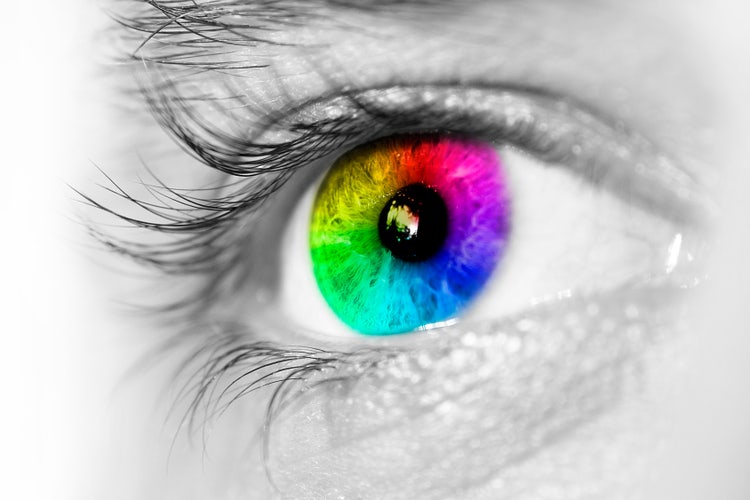Printed colors will soon be more vivid and accurate

Image credit: Adobe Stock/ REDPIXEL.
Visual perception provides a huge evolutionary advantage, which is why most animal species have eyeballs. A human retina contains 3 types of cones, about 4.5 million of them all together. Some cones detect red light, some green, and some blue. Each cone can distinguish approximately 100 shades, and our brain combines the incoming RGB (red-green-blue) signals from the optic nerve to perceive about a million different colors (1003). It’s a big palette — a firehose of colors to fuel the creative dreams of artists, photographers and graphic designers.
The colors of the visual palette can be represented numerically, stored digitally, and displayed on our RGB monitors. But reproducing those colors in print, consistently and faithfully, poses some serious challenges. It’s worth the effort to get it right. Printing breathes life into a design, makes it tangible and touchable in the physical world — on a product, a piece of paper, a billboard, a roll of fabric.
Trial-and-error color management is expensive, and a recipe for customer disappointment. Modern color management starts with a controlled “fingerprinted” printing condition, then works backwards to convert the design colors, which originate in different color space(s). The characteristics of the ink, the paper and the ambient lighting must all be taken into account. For example, glossy stock can carry a bigger gamut (broader range of colors) than newsprint.
Today, most printing uses a standard set of 4 process inks: Cyan, Magenta, Yellow and Black (CMYK). Each ink absorbs some frequencies of light and reflects others. For example, Cyan ink absorbs red light light, and reflects blue and green light. (Fun fact: Did you know that Magenta does not appear in the rainbow?) Thousands of colors can be emulated by these 4 basic inks. But there are limits. Even glossy stock imprinted with CMYK inks cannot carry all the colors displayed on a monitor. This poses a problem for brand owners. A brand color is quickly recognized by customers, and therefore constitutes a large part of the brand’s value. To achieve a specific desired color, one that may not be easily reproduced using standard CMYK inks, brand owners will specify a swatch in a book, and ink suppliers will formulate a special dedicated ink to match it.
Spot color inks have a long and successful track-record. But a new approach is making major inroads. Expanded Color Gamut (ECG) printing is breaching the limits of CMYK process and spot color printing. The ECG idea is not new. But it is finally getting some serious traction, driven by the rapid growth of digital inkjet printing. Manufacturers are adding ink stations to their inkjet presses, to be filled with Orange and/or Green and/or Violet inks (OGV), which complement the core CMYK process ink set.
Expanded Color Gamut printing is a game-changer, and not just for inkjet printing. Offset and flexographic printers are also getting on-board. With more colored inks available on-press (CMYK+OGV), special colors that could not be achieved with CMYK inks can be emulated, using less ink. As the name suggests, this expands the printable gamut for every type of press, paper and substrate.
- For designers — ECG means that printed images and graphics will look as vibrant as photographs.
- For brands owners — ECG means that a desired special color can be achieved without resorting to a specially formulated (i.e., expensive) ink.
- For press operators — ECG means that a single ink set can emulate almost all special colors, eliminating the need to drain and fill ink stations with spot color inks, saving time and money. Reducing the switching overhead between jobs is especially critical as run-lengths become shorter — enabling manufacturers and print service providers to run more jobs in the same amount of time.
The Adobe PDF Print Engine is the rendering platform built into market-leading print production solutions. Working closely with our partners, Adobe has delivered the latest color science and imaging technology to commercial and industrial printers, starting with version PDF Print Engine 1.0 in 2006. Version 6 was announced today. It includes some break-through color features, including single-stage, high-performance color conversions for efficient and precise output to ECG presses. The spectral brand color feature in PDF Print Engine 6 enables full color management for corporate spot colors defined by spectral values, not swatches or names. (A subject for another blog post.) Along with the other new capabilities, the latest release will open doors to next-generation print reproduction that will brighten our world with more vivid and accurate colors.